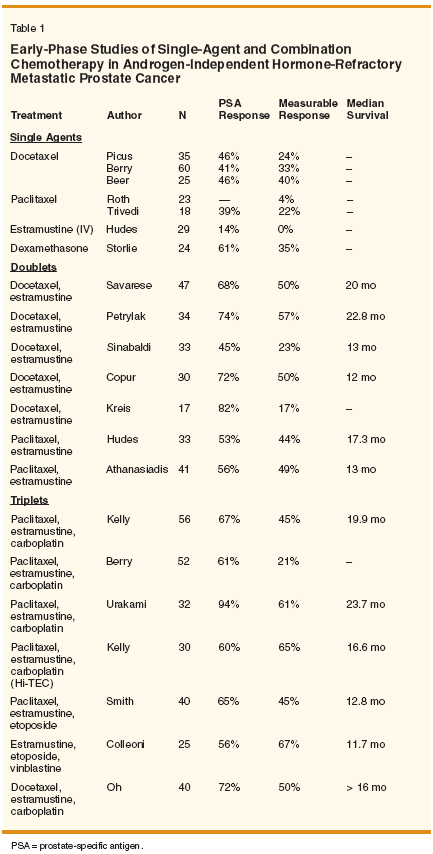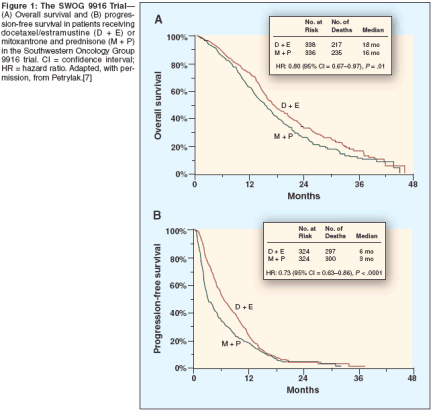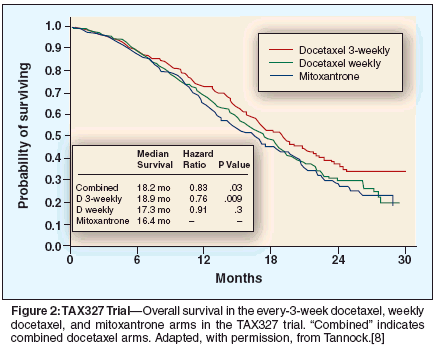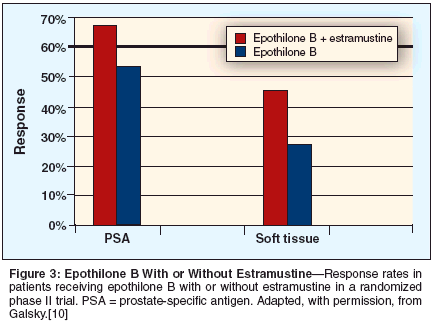Recent Progress in Management of Advanced Prostate Cancer
Androgen-deprivation therapy, usually with combined androgenblockade, is standard initial treatment for advanced prostate cancer.With failure of initial treatment, as indicated by rising prostate-specificantigen (PSA) levels, second-line hormonal therapy is usually instituted.Over the past several years, it has become increasingly clear thatsystemic chemotherapy has an important role in hormone-refractorydisease. Phase II trials have demonstrated high PSA and measurabledisease response rates with taxane single-agent and combination treatments.One recent phase III trial showed that docetaxel (Taxotere)/estramustine (Emcyt) significantly improved overall survival, progression-free survival, and PSA response rate compared with mitoxantrone(Novantrone) plus prednisone. Another phase III trial demonstratedthat docetaxel given every 3 weeks plus prednisone significantly improvedoverall survival, PSA response rate, pain relief response rate,and quality of life compared with mitoxantrone and prednisone. Onthe basis of these findings, every-3-week docetaxel plus prednisone isnow considered standard first-line therapy for metastatic hormonerefractorydisease. There is considerable optimism that treatment canbe further improved. Studies of taxane combinations with bevacizumab(Avastin), thalidomide (Thalomid), bortezomib (Velcade), antisenseBcl-2 oligonucleotide, mTOR inhibitors, epidermal growth factor receptorinhibitors, and KDR inhibitors are under way. Randomized phaseIII trials in progress or planned are examining docetaxel in combinationwith imatinib mesylate (Gleevec) or calcitriol and docetaxel/prednisonein combination with bevacizumab and an antisense clusterincompound. Other promising systemic agents include epothilones andatrasentan, and promising vaccines include Provenge, GVAX, andProstvac.
Androgen-deprivation therapy, usually with combined androgen blockade, is standard initial treatment for advanced prostate cancer. With failure of initial treatment, as indicated by rising prostate-specific antigen (PSA) levels, second-line hormonal therapy is usually instituted. Over the past several years, it has become increasingly clear that systemic chemotherapy has an important role in hormone-refractory disease. Phase II trials have demonstrated high PSA and measurable disease response rates with taxane single-agent and combination treatments. One recent phase III trial showed that docetaxel (Taxotere)/ estramustine (Emcyt) significantly improved overall survival, progression- free survival, and PSA response rate compared with mitoxantrone (Novantrone) plus prednisone. Another phase III trial demonstrated that docetaxel given every 3 weeks plus prednisone significantly improved overall survival, PSA response rate, pain relief response rate, and quality of life compared with mitoxantrone and prednisone. On the basis of these findings, every-3-week docetaxel plus prednisone is now considered standard first-line therapy for metastatic hormonerefractory disease. There is considerable optimism that treatment can be further improved. Studies of taxane combinations with bevacizumab (Avastin), thalidomide (Thalomid), bortezomib (Velcade), antisense Bcl-2 oligonucleotide, mTOR inhibitors, epidermal growth factor receptor inhibitors, and KDR inhibitors are under way. Randomized phase III trials in progress or planned are examining docetaxel in combination with imatinib mesylate (Gleevec) or calcitriol and docetaxel/prednisone in combination with bevacizumab and an antisense clusterin compound. Other promising systemic agents include epothilones and atrasentan, and promising vaccines include Provenge, GVAX, and Prostvac.
For decades, advanced prostate cancer was defined as disease with bone metastases at presentation. The development of prostatespecific antigen (PSA) measurements in the 1980s provided an improved method for diagnosing early prostate cancer. Currently, most patients are diagnosed with early disease; advanced disease is now considered to occur with relapse as shown by rising PSA levels after local therapy. There have been corresponding changes in management of disease. Treatment for symptomatic bone metastases for many years consisted of orchiectomy. The introduction of gonadotropin- releasing hormone agonists in the 1980s permitted earlier treatment of asymptomatic bone metastases. With the availability of PSA testing, increasing numbers of patients are treated with androgen-deprivation therapy (ADT) earlier in the disease course on the basis of rising PSA. Androgen-Deprivation Therapy in Advanced Disease Androgen-deprivation therapy remains the best treatment for metastatic prostate cancer. The duration of effectiveness is approximately 18 months in this setting. Androgen-deprivation therapy consists of orchiectomy or hormonal therapies that include luteinizing hormone-releasing hormone (LHRH) agonists and antagonists, estrogens, and combined androgen blockade (blockade of both adrenal and testicular androgen production) with, for example, an LHRH analog and an antiandrogen agent such as bicalutamide (Casodex). Randomized trials have shown little difference in efficacy among hormonal therapies, although there are differences in adverse effect profiles that can influence treatment decisions.

Many practitioners consider combined androgen blockade to be the standard of care in metastatic disease. Median survival with ADT in patients with bone metastases is approximately 3 to 5 years. It has become evident that the duration of effectiveness of ADT in patients treated for relapse defined by rising PSA is prolonged beyond that observed in those with bone metastases; median survival in patients without bone metastases is 8 to 12 years. An initial step after failure of initial ADT is withdrawal of the antiandrogen agent. It was observed approximately 10 years ago that withdrawal of flutamide was associated with a PSA response in about 20% of patients[1]; this antiandrogen withdrawal syndrome has been also been observed with bicalutamide and nilutamide (Nilandron). The responses are clinically significant in many cases, but of short duration. Potential explanations for this effect include mutation of the androgen receptor and changes in coactivators that allow the antiandrogen agent to act as a growth stimulant. In part due to investigation of this phenomenon, it is now recognized that the androgen receptor is still active and can still serve as a therapeutic target in patients with hormone-refractory disease. A major goal of current investigations is the development of antiandrogen agents with improved targeting of androgen receptors. After withdrawal of the antiandrogen, secondary hormonal therapy is usually initiated. In this setting, reported PSA response rates are[2] 9% with prednisone, 22% with hydrocortisone, 23% with high-dose bicalutamide, 43% with diethylstilbestrol (DES), 63% with ketoconazole, and 75% with the nutritional supplement PC-SPES. The high response rates observed with PC-SPES prompted considerable enthusiasm; the substance was withdrawn from the market after it was found to be contaminated with DES or other prescription substances. In randomized comparisons, response rates have been lower. For example, in a comparative trial, Oh et al[3] found response rates of 20% to 25% with DES and 40% to 50% with PC-SPES.

Chemotherapy More recently, chemotherapy has found a place in the treatment of hormone- refractory prostate cancer. The first trial to demonstrate the utility of chemotherapy in this setting was a Canadian study[4] in which 161 patients with symptomatic hormone-refractory disease were randomized to prednisone at 10 mg/d or prednisone at the same dosage plus mitoxantrone (Novantrone) at 12 mg/m2. The primary end point was palliation of pain. Overall, there was a modest but significant improvement in pain relief response (29% vs 12%, P = .01) and a significant increase in response duration (43 vs 18 weeks, P < .0001) with mitoxantrone plus prednisone. In a subsequent Cancer and Leukemia Group B (CALGB) trial,[5] 242 patients with hormone-refractory disease were randomized to receive hy-drocortisone at 40 mg/d or hydrocortisone at the same dosage plus mitoxantrone at 14 mg/m2, with the primary end point of the trial being overall survival. No difference in median overall survival was observed between hydrocortisone alone and mitoxantrone plus hydrocortisone (12.6 vs 12.3 months); however, the modest but appreciable pain relief observed with mitoxantrone treatment in the Canadian study was confirmed. Mitoxantrone was well tolerated, with minimal nausea, no alopecia, and low cardiac toxicity observed; grade IV neutropenia occurred in 32% of patients, with febrile neutropenia occurring in 1%. On the basis of these findings, the US Food and Drug Adminstration (FDA) approved mitoxantrone as a palliative agent in the treatment of symptomatic metastatic disease.


In the early 1990s, agents such as vinblastine and doxorubicin were evaluated in hormone-refractory disease and showed some activity. However, it was with the introduction of the taxanes in the mid-1990s that the real potential for chemotherapy in hormone-refractory metastatic disease was recognized. In phase II studies, single-agent taxane treatment resulted in PSA response rates of 40% or greater and taxane/estramustine (Emcyt) combinations produced response rates of 45% to 82% with higher measurable response rates than those observed with single-agent treatment (Table 1)[6]; similarly, taxane triplets have produced high PSA and measurable response rates in phase II trials. These findings led to two large prospective randomized phase III trials of taxane-based therapy, results of which were recently reported. In the Southwestern Oncology Group (SWOG) 9916 trial,[7] 674 patients with advanced hormone-refractory disease were randomized to receive docetaxel at 60 mg/m2 on day 2 and estramustine at 280 mg tid on days 1 to 5 every 3 weeks, or prednisone at 5 mg bid daily plus mitoxantrone at 12 mg/m2 on day 1 every 3 weeks. The docetaxel/estramustine arm exhibited a significant 20% increase (95% confidence interval [CI] = 3%-33%, P < .01) in overall survival and a significant 27% increase (95% CI = 14%-37%, P < .0001) in progressionfree survival (Figure 1); docetaxel/ estramustine treatment was also associated with a significant improvement in PSA response rate (50% vs 27%, P < .0001) and a nonsignificantly better objective response rate (17% vs 11%, P = .15). Higher rates of toxicity were seen with docetaxel/estramustine; however, there was no difference in toxic death rates or rates of study discontinuation between treatments. In the TAX327 trial,[8] 1,006 pa-tients with hormone-refractory disease were randomized to either (1) docetaxel (Taxotere) at 75 mg/m2 every 3 weeks plus prednisone at 10 mg/d, (2) docetaxel at 30 mg/m2 weekly plus prednisone at 10 mg/d, or (3) mitoxantrone at 12 mg/m2 every 3 weeks plus prednisone at 10 mg/d. The pooled docetaxel arms exhibited a significant 17% improvement in overall survival (hazard ratio 0.83, P = .03) (Figure 2). The improvement in overall survival was significant for the every-3-week docetaxel regimen (24% reduction in risk of death; hazard ratio 0.76, 95% CI = 0.62-0.94, P = .009), but not for the weekly docetaxel regimen. Compared with the mitoxantrone regimen, the every-3- week docetaxel regimen was also associated with a significantly improved PSA response rate (45% vs 32%, P < .0005), a significantly improved pain response rate (35% vs 22%, P = .01), and significant improvements in quality-of-life measures. These studies led to the recent approval of docetaxel administered every 3 weeks plus prednisone for treatment of metastatic prostate cancer. Among the issues left open by these findings are the role of weekly docetaxel treatment and the potential role of estramustine in taxane combinations. With regard to the latter, although phase II trials indicated that the addition of estramustine to docetaxel improved response rates, and although the combination was superior to mitoxantrone/ prednisone in the SWOG 9916 trial, the median overall survival in the combination arm in the SWOG trial (18 months) was similar to the survival with docetaxel alone in the TAX327 study (18.9 months with the every-3-week regimen). In the absence of a direct comparison of docetaxel/estramustine vs docetaxel alone it thus remains unclear whether the use of estramustine confers any survival benefit. Indirect evidence of a potential benefit comes from earlier combination studies. For example, a randomized trial comparing estramustine at 600 mg/m2 plus vinblastine at 4 mg/m2 weekly vs vinblastine alone in 201 patients with hormone-refractory disease[9] showed a significant improvement in progression- free survival (median 3.71 vs 2.20 months, P < .0004) and a trend toward improvement in the primary end point of overall survival (median 11.9 vs 9.2 months, P = .08) in the estramustine arm. Rather than representing a momentous advance in the treatment of hormone- refractory disease, the trials of docetaxel therapy really provide proof of principle that chemotherapy can prolong survival and open the way for evaluation of combination treatment involving a number of interesting compounds. For now, docetaxel on an every-3-week schedule plus prednisone is considered the standard first-line therapy for metastatic hormone- refractory disease. The role of estramustine in treatment is uncertain, but most practitioners are not using this agent. The efficacy of second-line agents such as mitoxantrone remains undefined. Phase II trials of combinations of docetaxel with a variety of agents have been completed, are under way, or are planned, including combinations with bevacizumab (Avastin), thalidomide (Thalomid), bortezomib (Velcade), antisense Bcl-2 oligonucleotide, mTOR inhibitors, epidermal growth factor receptor inhibitors, KDR (vascular endothelial growth factor receptor-2) inhibitors, and calcitriol. Randomized phase III trials in progress or planned include studies of docetaxel with/without imatinib mesylate (Gleevec) at several centers (M. D. Anderson Cancer Center, Dana-Farber Cancer Institute, Memorial Sloan-Kettering Cancer Center, University of California-San Francisco, and University of Michigan), docetaxel and prednisone with/without bevacizumab (CALGB trial), docetaxel and prednisone with/without an antisense clusterin (proapoptotic) compound, and docetaxel with/without calcitriol, as well as a study of prednisone with/without satraplatin. Other Promising Systemic Agents Other promising systemic agents include epothilones, which are being examined in early phase studies by a number of groups. In one multicenter randomized phase II trial,[10] 92 patients received epothilone B (BMS- 247550) at 35 mg/m2 IV on day 2, estramustine at 280 mg tid on days 1 to 5, and warfarin (Coumadin) (pretreatment for potential estramustinerelated thrombosis) at 2 mg/d every 21 days or epothilone B at 35 mg/m2 on day 1 every 21 days; pretreatment for epothilone B consisted of diphenhydramine at 50 mg and ranitidine at 150 mg. The PSA response rate was greater than 50% with epothilone B alone and higher with combined treatment, and the soft good response rates were observed in soft-tissue disease in both groups (Figure 3). A randomized phase II trial[11] of the endothelin receptor antagonist atrasentan suggested a significant effect of this agent in prolonging disease- free survival. A follow-up phase III trial failed to confirm these results; however, the drug was effective in the bone-only subset of patients. A number of vaccines are in phase III evaluation, including Provenge (dendritic cell approach), GVAX, and Prostvac (poxvirus approach). The Provenge vaccine had initially been found to provide a disease progression benefit in hormone-refractory disease in patients with a Gleason score of ≤ 7[12]; a recent report indicates that advantages in progression-free and overall survival have been observed across all grades after 3 years of follow up. Currently, a phase III trial is under way in patients with Gleason scores of ≤ 7. The bisphosphonate zoledronic acid (Zometa) is being assessed in a phase III trial in prevention of disease progression. Phase II studies are under way to evaluate the effects of anti-PSMA (prostate specific membrane antigen) antibodies coupled to radioisotopes and toxins.
Disclosures:
The author has no significant financial interest or other relationship with the manufacturers of any products or providers of any service mentioned in this article.
References:
1. Scher HI, Kelly WK: Flutamide withdrawal syndrome: Its impact on clinical trials in hormone-refractory prostate cancer. J Clin Oncol 11:1566-1572, 1993.
2. Oh WK: Secondary hormonal therapies in the treatment of prostate cancer. Urology 60(3 suppl 1):87-92, 2002.
3. Oh WK, Kantoff PW, Weinberg V, et al: Prospective, multicenter, randomized phase II trial of the herbal supplement, PC-SPES, and diethylstilbestrol in patients with androgen-independent prostate cancer. J Clin Oncol 22:3657-3659, 2004.
4. Tannock IF, Osoba D, Stockler MR, et al: Chemotherapy with mitoxantrone plus prednisone or prednisone alone for symptomatic hormone-resistant prostate cancer: A Canadian randomized trial with palliative end points. J Clin Oncol 14:1756-1764, 1996.
5. Kantoff PW, Halabi S, Conaway M, et al: Hydrocortisone with or without mitoxantrone in men with hormone-refractory prostate cancer : Results of the Cancer and Leukemia Group B 9182 study. J Clin Oncol 17:2506-2513, 1999.
6. Oh WK: The evolving role of chemotherapy and other systemic therapies managing localized prostate cancer. J Urol 170(6 pt 2):S28-S34, 2003.
7. Petrylak DP, Tangen CM, Hussain MHA, et al : Docetaxel and estramustine compared with mitoxantrone and prednisone for advanced refractory prostate cancer. N Engl J Med 351:1513-1520, 2004.
8. Tannock IF, de Wit R, Berry WR, et al: Docetaxel plus prednisone or mitoxantrone plus prednisone for advanced prostate cancer. N Engl J Med 351:1502-1512, 2004.
9. Hudes G, Einhorn L, Ross E, et al: Vinblastine versus vinblastine plus oral estramustine phosphate for patients with hormone- refractory prostate cancer: A Hoosier Oncology Group and Fox Chase Network phase III trial. J Clin Oncol 17:3160-3166, 1999.
10. Galsky MD, Small EJ, Oh WK, et al: Multi-institutional randomized phase II trial of the epothilone B analogue ixabepilone (BMS- 247550) with or without estramustine phosphate in patients with progressive castrate metastatic prostate cancer. J Clin Oncol 23:1439- 1446, 2005.
11. Carducci MA, Padley RJ, Breul J, et al: Effect of endothelin-A receptor blockade with atrasentan on tumor progression in men with hormone-refractory prostate cancer: A randomized, phase II, placebo-controlled trial. J Clin Oncol 21:679-689, 2003.
12. Small EJ, Rini B, Higano C, et al: A randomized, placebo-controlled phase III trial of APC8015 in patients with androgen-independent prostate cancer (AiPCa) (abstract 1534). Proc Am Soc Clin Oncol 22:382, 2003.